Hist 2111 final powerpoint
Download as pptx, pdf1 like497 views
The document summarizes the key events in establishing the US government under the Constitution between 1777-1789. It describes the weaknesses of the Articles of Confederation, the calls for a stronger federal government, and the compromises reached at the Constitutional Convention to overcome disagreements between large and small states, as well as over the issue of slavery representation. The Constitution was then ratified through the efforts of Federalists to gain approval from enough states.
1 of 8
Download to read offline
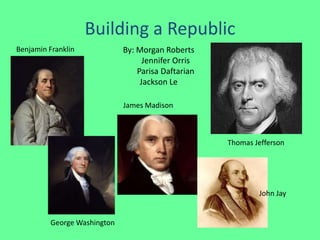
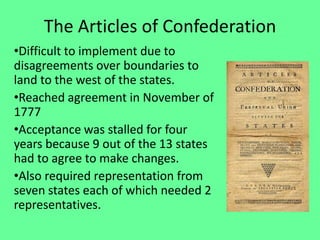
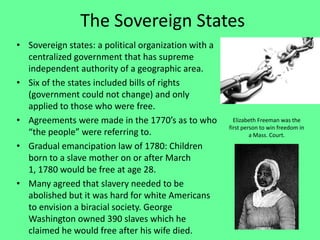
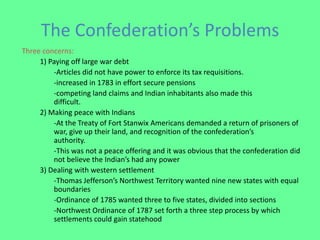
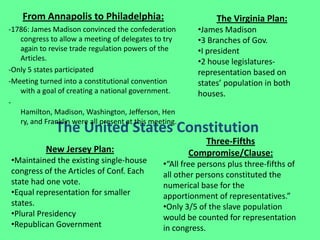
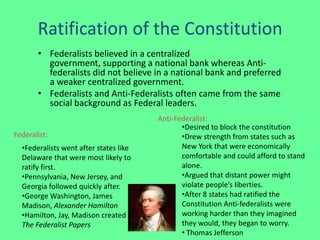
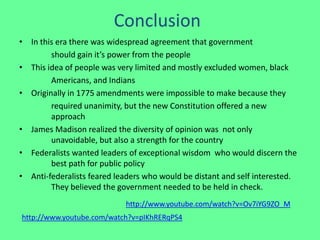
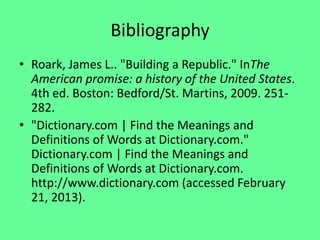
Ad
Recommended
U.S. History Review
U.S. History ReviewDavid Billett
Ìı
The document provides an overview of several key events and developments in U.S. history from the 1700s to the Civil War era. It discusses the Great Awakening, the Declaration of Independence, the Articles of Confederation, Shays' Rebellion, the U.S. Constitution, the Bill of Rights, political figures like Jefferson and Hamilton, and major court cases. It also summarizes the causes and impacts of the Civil War, key battles, emancipation, Reconstruction, and resistance to rights for freed slaves.C&e unit 1 powerpoint
C&e unit 1 powerpointtessakh
Ìı
This document summarizes different types of governments and the development of government in both Europe and the American colonies. It discusses the transition from colonies being ruled by England to the establishment of representative democracy in the United States. Key events include the signing of the Magna Carta, Enlightenment thinkers influencing ideas of government, various acts passed by Britain that taxed the colonies leading to the American Revolution, the writing and signing of the Declaration of Independence, challenges faced under the Articles of Confederation, and compromises made at the Constitutional Convention to establish the US system of government.Foundations of American Government
Foundations of American Governmenttessakh
Ìı
This document summarizes different types of governments and the development of government in both Europe and the American colonies. It discusses the transition from colonies being ruled by England to the establishment of representative democracy in the United States, including the writing of the Declaration of Independence, the Articles of Confederation, the U.S. Constitution, and compromises reached at the Constitutional Convention.C&e unit 1 powerpoint
C&e unit 1 powerpointtessakh
Ìı
This document summarizes different types of governments and the development of government in both Europe and the American colonies. It discusses the transition from colonies being ruled by England to the establishment of representative democracy in the United States, including the writing of the Declaration of Independence, the Articles of Confederation, the U.S. Constitution, and compromises reached at the Constitutional Convention.C&e unit 1 powerpoint
C&e unit 1 powerpointtessakh
Ìı
This document summarizes different types of governments and the development of government in both Europe and the American colonies. It discusses the transition from colonies being ruled by England to the establishment of representative democracy in the United States, including the writing of the Declaration of Independence, the Articles of Confederation, the U.S. Constitution, and compromises reached at the Constitutional Convention.C&e unit 1 powerpoint
C&e unit 1 powerpointtessakh
Ìı
This document outlines different forms of government such as monarchy, dictatorship, theocracy, oligarchy, and democracy. It discusses the branches of government and how power is divided. It provides context on the development of government in England and its colonies in America, including significant documents and events that led to the American Revolution and challenges the new nation faced in forming its own government under the Articles of Confederation and eventual Constitution.Soc studies #21 thomas jefferson
Soc studies #21 thomas jeffersonMrsSevCTK
Ìı
Thomas Jefferson was elected the third US President in 1800. During his two terms, he oversaw the Louisiana Purchase which doubled the size of the US, established judicial review in the Marbury v. Madison Supreme Court case, and issued the Embargo Act in an attempt to punish Britain and France for trade issues but which damaged the US economy instead. An expedition led by Meriwether Lewis and William Clark also explored the new western lands.Civics - Chapter 5
Civics - Chapter 5Christopher Rowland
Ìı
The document summarizes the key events of the Constitutional Convention in Philadelphia in 1787. Delegates debated proposals like the Virginia Plan for a bicameral legislature based on population and the New Jersey Plan for a unicameral legislature with equal representation. They reached compromises including the Great Compromise that blended the two approaches and the Three-Fifths Compromise on counting slaves. Opposition from Anti-Federalists concerned with states' and individual rights was addressed by the Federalists' agreement to add a Bill of Rights to the new Constitution.12 constitutional convention-1_3 (1) (1)
12 constitutional convention-1_3 (1) (1)kellycrowell
Ìı
The document summarizes the key events and outcomes of the 1787 Constitutional Convention. It notes that 55 delegates from 12 states (except Rhode Island) attended, including George Washington, Benjamin Franklin, and James Madison. They decided to discard the Articles of Confederation and write a new Constitution. There were opposing plans from James Madison and the small states, which were resolved by compromises, including equal representation of states in the Senate and proportional representation in the House. The Constitution was then ratified after intense debate between Federalists and opponents.Module five constitutional convention
Module five constitutional conventionkellycrowell
Ìı
The document summarizes the key events and outcomes of the 1787 Constitutional Convention. It notes that 55 delegates from 12 states (except Rhode Island) attended, including George Washington, Benjamin Franklin, and James Madison. They decided to discard the Articles of Confederation and write a new Constitution. There were opposing plans from James Madison and the small states, which were resolved by compromises, including equal representation of states in the Senate and proportional representation in the House. The Constitution was then ratified after intense debate between Federalists and opponents.Lesson 2 Philadelphia Convention
Lesson 2 Philadelphia Conventionms_mcmanus
Ìı
The Philadelphia Convention was convened in May 1787 to address problems in governing the United States under the Articles of Confederation. 55 delegates attended, though key figures like Thomas Jefferson and Patrick Henry did not. James Madison had called for revisions to improve the Articles of Confederation. The convention decided to create an entirely new constitution instead, keeping their discussions secret. They debated plans like the Virginia Plan, which proposed a strong national government, and the New Jersey Plan, which proposed keeping power with the states. Through compromise, they developed a new constitution with a balanced federal government consisting of three branches having checks on each other.Chapter 5 - U.S. Government
Chapter 5 - U.S. Government CarmichaelWCHS
Ìı
This document provides information about political parties in the United States. It defines a political party as a group that seeks to control government by winning elections and holding public office. The two major parties are the Republicans and Democrats. Political parties serve several functions, including nominating candidates, informing and inspiring voters, and ensuring candidates are qualified. Minor parties also exist but do not have wide support. The US system encourages two major parties due to single-member districts and plurality voting.Constitutional convention
Constitutional conventiondnm_mccoy
Ìı
The Constitutional Convention began on May 25, 1787 in Philadelphia to improve the failing Articles of Confederation. George Washington presided over the convention and James Madison took extensive notes. The delegates debated issues such as the balance of power between federal and state governments, representation in Congress, and the divisive issue of slavery. They proposed plans like the Virginia Plan for a stronger national government and the New Jersey Plan favoring state power. The Great Compromise created a bicameral legislature to balance state and population-based representation. Further compromises addressed slavery, including the Three-Fifths Compromise to determine representation and taxes based on population including slaves.U.S. Government -- Chater 2,Section 5 "Ratifying the Constitution"
U.S. Government -- Chater 2,Section 5 "Ratifying the Constitution"CarmichaelWCHS
Ìı
The document discusses the ratification of the US Constitution. It describes the two sides, with Federalists favoring ratification as they saw the weaknesses of the Articles of Confederation, led by figures like James Madison and Alexander Hamilton. Anti-Federalists opposed ratification, led by Patrick Henry and Thomas Jefferson, concerned about increased central government power without protections like a bill of rights. The Constitution was narrowly ratified, with key states like Virginia and New York approving it after debates. George Washington was then elected the first US President.The First President
The First PresidentBlake Harris
Ìı
George Washington was elected as the first President of the United States. He faced challenges in establishing the role of the presidency and setting precedents for the new government. Washington appointed the first cabinet, including Thomas Jefferson as Secretary of State and Alexander Hamilton as Secretary of Treasury. Hamilton proposed an ambitious economic plan that was opposed by Southern states. Washington issued the Proclamation of Neutrality to keep America out of conflicts between European nations. He later declined to run for a third term, warning of the dangers of political parties in his farewell address.Building The New American Nation131
Building The New American Nation131grieffel
Ìı
The document provides background information on the Constitutional Convention of 1787, including that it was called to revise the Articles of Confederation but ultimately led to the drafting of an entirely new constitution. It notes that 55 delegates from 12 states met in Philadelphia from May to September 1787 and produced the US Constitution. Key facts include that James Madison is considered the "Father of the Constitution" and Rhode Island was the only state not represented.Constitutional Convention
Constitutional ConventionKyle Davoust
Ìı
The Constitutional Convention was called in 1787 to address issues with the Articles of Confederation. 55 delegates from 13 states attended, including key figures like James Madison, George Washington, and Alexander Hamilton. The convention began by considering the Virginia Plan which proposed a new government with three branches, but the smaller states opposed this. They proposed the New Jersey Plan with equal state representation instead. The Great Compromise blended these ideas by creating a bicameral legislature with proportional representation in the House and equal representation in the Senate. Further compromises included counting 3/5 of slaves toward state populations. The completed Constitution was sent to states for ratification, dividing Federalists who supported it from Antifederalists who opposed its strong national governmentJefferson Alters the Nation's Course
Jefferson Alters the Nation's CourseMatthew Caggia
Ìı
The election of 1800 resulted in Thomas Jefferson's victory over John Adams, marking a significant political shift. Jefferson implemented key changes during his presidency, including reducing the size of government and military, and favoring free trade, which contributed to the decline of Federalist power. Landmark cases like Marbury v. Madison established the principle of judicial review, while the Louisiana Purchase doubled U.S. territory and expanded federal power.Foreign Affairs Trouble the Nation
Foreign Affairs Trouble the NationMatthew Caggia
Ìı
The document outlines key events and treaties from early U.S. history, including Washington's declaration of neutrality, the victory at the Battle of Fallen Timbers, and subsequent treaties with Britain and Spain. It discusses the rise of sectionalism and political division during the election of 1796, highlighted by the XYZ Affair, which led to anti-French sentiment and military preparations. Additionally, it explains the Alien and Sedition Acts, which targeted foreigners and dissent, and the resulting Virginia and Kentucky Resolutions asserting states' rights to nullify federal laws.Foundations of Government
Foundations of Governmentengdkyl
Ìı
This document provides an overview of foundational concepts of government. It discusses quotes from philosophers like Goethe, Hobbes, and Madison on the nature of ruling and governing. It defines key terms like government, the state, democracy, republic, and dictatorship. It outlines the theoretical origins of the state and different forms of democracy and their features. The document then discusses the historical foundations of the US government, including the Magna Carta, Continental Congresses, the Declaration of Independence, Articles of Confederation, Philadelphia Convention, and the US Constitution. It analyzes the major principles and structures of the American constitutional government system, including federalism, separation of powers, checks and balances, and constitutional amendment.3.2 launching the new nation [1789 1816]
3.2 launching the new nation [1789 1816]jtoma84
Ìı
Washington reluctantly accepted the presidency and had to establish the new government's structure and policies with little precedent to guide them. Hamilton and Jefferson debated federal powers, with Hamilton favoring a strong national government supported by wealthy creditors and Jefferson emphasizing states' rights and individual liberties. The establishment of political parties and Hamilton's economic plans laid the foundation for how the new American government would function.23 Thomas Jefferson (II)
23 Thomas Jefferson (II)Daniel Davis Wood
Ìı
The document discusses Thomas Jefferson's views and actions, highlighting the contrasting perspectives of broad and strict constructionists regarding federal powers. It examines Jefferson's personal contradictions, such as owning slaves while advocating for equality, his deistic beliefs evidenced by his rewritten version of the New Testament, and his idealization of the yeoman farmer. Additionally, it covers the significance of the Supreme Court case Marbury v. Madison, which established the principle of constitutional review.The age of jackson ssush7a
The age of jackson ssush7aphillipgrogers
Ìı
The Age of Jackson marked significant political, economic, and social developments, with Andrew Jackson challenging the Democratic-Republicans and advocating for universal male suffrage. Jacksonian democracy emphasized public participation in politics, the spoils system, and deepened sectionalism, particularly evident during the nullification crisis over tariffs. The Indian Removal Act of 1830 facilitated the forced relocation of Native Americans, exemplifying the era's policies that prioritized white settlement, culminating in tragic events like the Trail of Tears.United states government
United states governmentmikedunton
Ìı
The document summarizes the early government of the United States, from the Articles of Confederation to the ratification of the Constitution. It describes how the original 13 states each had their own government, and then joined together under the Articles of Confederation, which gave most power to state governments. However, problems with the Articles led to a Constitutional Convention that established a new national government with three branches and compromises between large and small states. The Constitution was then ratified and George Washington became the first President.Declaration of independence
Declaration of independence markittrell
Ìı
The document summarizes the key events and components of the Declaration of Independence. It describes how the Second Continental Congress appointed a committee to draft the declaration in 1776, with Thomas Jefferson as the main author. The declaration had four main parts: the preamble introduced why Congress wrote it; the declaration of natural rights stated people's inherent rights; a list of grievances cited 28 complaints against King George III; and the resolution of independence declared the 13 colonies free and independent states.Washington through war of 1812 a
Washington through war of 1812 akellycrowell
Ìı
George Washington establishes the first Cabinet and shapes the executive branch. Alexander Hamilton and Thomas Jefferson disagree over interpreting the Constitution, leading to the first political parties. Hamilton establishes economic plans that spark debate and opposition. Washington's presidency helps transform the new nation's founding principles into a functioning government.Bill of Rights and Incorporation
Bill of Rights and Incorporationkryackey
Ìı
The document summarizes the creation and ratification of the US Constitution. It describes how the Constitution was drafted at the Constitutional Convention in 1787 and signed on September 17th. It then discusses the ratification process, the Federalist and Antifederalist debates, compromises reached at the convention, and the addition of the Bill of Rights to address states' concerns.Constitutionalconvention1787 131122112046-phpapp01
Constitutionalconvention1787 131122112046-phpapp01Sandra Waters
Ìı
The 1787 Constitutional Convention in Philadelphia debated major issues around representation in the new federal government. The Virginia Plan proposed representation based on population, favoring large states, while the New Jersey Plan proposed equal representation for each state, favoring small states. Roger Sherman created The Great Compromise with two houses: the House based on population and the Senate with two members per state. They also debated whether slaves should be counted as whole persons to determine representation. The Three-Fifths Compromise was created to count each slave as three-fifths of a person for both representation and taxation purposes.3. shaping a new nation [1782 1788]
3. shaping a new nation [1782 1788]jtoma84
Ìı
The Federalists argued that the Constitution established a balanced government that protected individual rights through separation of powers and checks and balances, while the Anti-Federalists believed it gave too much power to the central government and lacked protections for individual liberties. A compromise was reached with the addition of the Bill of Rights, which addressed many of the Anti-Federalist concerns and helped secure ratification in several key states.His 121 chapter 6 7 a new nation
His 121 chapter 6 7 a new nationdcyw1112
Ìı
The document provides an overview of key events and developments during the early years of the United States as an independent nation under the Articles of Confederation and then the newly ratified Constitution. It discusses the weaknesses of the Articles, events like Shays' Rebellion that highlighted these weaknesses, the drafting and ratification of the Constitution, as well as major policies and conflicts during the Federalist Era under presidents Washington and Adams. Key figures and developments discussed include the Northwest Ordinance, Hamilton's economic plans, the emergence of political parties, and international tensions with Britain and France.More Related Content
What's hot (20)
12 constitutional convention-1_3 (1) (1)
12 constitutional convention-1_3 (1) (1)kellycrowell
Ìı
The document summarizes the key events and outcomes of the 1787 Constitutional Convention. It notes that 55 delegates from 12 states (except Rhode Island) attended, including George Washington, Benjamin Franklin, and James Madison. They decided to discard the Articles of Confederation and write a new Constitution. There were opposing plans from James Madison and the small states, which were resolved by compromises, including equal representation of states in the Senate and proportional representation in the House. The Constitution was then ratified after intense debate between Federalists and opponents.Module five constitutional convention
Module five constitutional conventionkellycrowell
Ìı
The document summarizes the key events and outcomes of the 1787 Constitutional Convention. It notes that 55 delegates from 12 states (except Rhode Island) attended, including George Washington, Benjamin Franklin, and James Madison. They decided to discard the Articles of Confederation and write a new Constitution. There were opposing plans from James Madison and the small states, which were resolved by compromises, including equal representation of states in the Senate and proportional representation in the House. The Constitution was then ratified after intense debate between Federalists and opponents.Lesson 2 Philadelphia Convention
Lesson 2 Philadelphia Conventionms_mcmanus
Ìı
The Philadelphia Convention was convened in May 1787 to address problems in governing the United States under the Articles of Confederation. 55 delegates attended, though key figures like Thomas Jefferson and Patrick Henry did not. James Madison had called for revisions to improve the Articles of Confederation. The convention decided to create an entirely new constitution instead, keeping their discussions secret. They debated plans like the Virginia Plan, which proposed a strong national government, and the New Jersey Plan, which proposed keeping power with the states. Through compromise, they developed a new constitution with a balanced federal government consisting of three branches having checks on each other.Chapter 5 - U.S. Government
Chapter 5 - U.S. Government CarmichaelWCHS
Ìı
This document provides information about political parties in the United States. It defines a political party as a group that seeks to control government by winning elections and holding public office. The two major parties are the Republicans and Democrats. Political parties serve several functions, including nominating candidates, informing and inspiring voters, and ensuring candidates are qualified. Minor parties also exist but do not have wide support. The US system encourages two major parties due to single-member districts and plurality voting.Constitutional convention
Constitutional conventiondnm_mccoy
Ìı
The Constitutional Convention began on May 25, 1787 in Philadelphia to improve the failing Articles of Confederation. George Washington presided over the convention and James Madison took extensive notes. The delegates debated issues such as the balance of power between federal and state governments, representation in Congress, and the divisive issue of slavery. They proposed plans like the Virginia Plan for a stronger national government and the New Jersey Plan favoring state power. The Great Compromise created a bicameral legislature to balance state and population-based representation. Further compromises addressed slavery, including the Three-Fifths Compromise to determine representation and taxes based on population including slaves.U.S. Government -- Chater 2,Section 5 "Ratifying the Constitution"
U.S. Government -- Chater 2,Section 5 "Ratifying the Constitution"CarmichaelWCHS
Ìı
The document discusses the ratification of the US Constitution. It describes the two sides, with Federalists favoring ratification as they saw the weaknesses of the Articles of Confederation, led by figures like James Madison and Alexander Hamilton. Anti-Federalists opposed ratification, led by Patrick Henry and Thomas Jefferson, concerned about increased central government power without protections like a bill of rights. The Constitution was narrowly ratified, with key states like Virginia and New York approving it after debates. George Washington was then elected the first US President.The First President
The First PresidentBlake Harris
Ìı
George Washington was elected as the first President of the United States. He faced challenges in establishing the role of the presidency and setting precedents for the new government. Washington appointed the first cabinet, including Thomas Jefferson as Secretary of State and Alexander Hamilton as Secretary of Treasury. Hamilton proposed an ambitious economic plan that was opposed by Southern states. Washington issued the Proclamation of Neutrality to keep America out of conflicts between European nations. He later declined to run for a third term, warning of the dangers of political parties in his farewell address.Building The New American Nation131
Building The New American Nation131grieffel
Ìı
The document provides background information on the Constitutional Convention of 1787, including that it was called to revise the Articles of Confederation but ultimately led to the drafting of an entirely new constitution. It notes that 55 delegates from 12 states met in Philadelphia from May to September 1787 and produced the US Constitution. Key facts include that James Madison is considered the "Father of the Constitution" and Rhode Island was the only state not represented.Constitutional Convention
Constitutional ConventionKyle Davoust
Ìı
The Constitutional Convention was called in 1787 to address issues with the Articles of Confederation. 55 delegates from 13 states attended, including key figures like James Madison, George Washington, and Alexander Hamilton. The convention began by considering the Virginia Plan which proposed a new government with three branches, but the smaller states opposed this. They proposed the New Jersey Plan with equal state representation instead. The Great Compromise blended these ideas by creating a bicameral legislature with proportional representation in the House and equal representation in the Senate. Further compromises included counting 3/5 of slaves toward state populations. The completed Constitution was sent to states for ratification, dividing Federalists who supported it from Antifederalists who opposed its strong national governmentJefferson Alters the Nation's Course
Jefferson Alters the Nation's CourseMatthew Caggia
Ìı
The election of 1800 resulted in Thomas Jefferson's victory over John Adams, marking a significant political shift. Jefferson implemented key changes during his presidency, including reducing the size of government and military, and favoring free trade, which contributed to the decline of Federalist power. Landmark cases like Marbury v. Madison established the principle of judicial review, while the Louisiana Purchase doubled U.S. territory and expanded federal power.Foreign Affairs Trouble the Nation
Foreign Affairs Trouble the NationMatthew Caggia
Ìı
The document outlines key events and treaties from early U.S. history, including Washington's declaration of neutrality, the victory at the Battle of Fallen Timbers, and subsequent treaties with Britain and Spain. It discusses the rise of sectionalism and political division during the election of 1796, highlighted by the XYZ Affair, which led to anti-French sentiment and military preparations. Additionally, it explains the Alien and Sedition Acts, which targeted foreigners and dissent, and the resulting Virginia and Kentucky Resolutions asserting states' rights to nullify federal laws.Foundations of Government
Foundations of Governmentengdkyl
Ìı
This document provides an overview of foundational concepts of government. It discusses quotes from philosophers like Goethe, Hobbes, and Madison on the nature of ruling and governing. It defines key terms like government, the state, democracy, republic, and dictatorship. It outlines the theoretical origins of the state and different forms of democracy and their features. The document then discusses the historical foundations of the US government, including the Magna Carta, Continental Congresses, the Declaration of Independence, Articles of Confederation, Philadelphia Convention, and the US Constitution. It analyzes the major principles and structures of the American constitutional government system, including federalism, separation of powers, checks and balances, and constitutional amendment.3.2 launching the new nation [1789 1816]
3.2 launching the new nation [1789 1816]jtoma84
Ìı
Washington reluctantly accepted the presidency and had to establish the new government's structure and policies with little precedent to guide them. Hamilton and Jefferson debated federal powers, with Hamilton favoring a strong national government supported by wealthy creditors and Jefferson emphasizing states' rights and individual liberties. The establishment of political parties and Hamilton's economic plans laid the foundation for how the new American government would function.23 Thomas Jefferson (II)
23 Thomas Jefferson (II)Daniel Davis Wood
Ìı
The document discusses Thomas Jefferson's views and actions, highlighting the contrasting perspectives of broad and strict constructionists regarding federal powers. It examines Jefferson's personal contradictions, such as owning slaves while advocating for equality, his deistic beliefs evidenced by his rewritten version of the New Testament, and his idealization of the yeoman farmer. Additionally, it covers the significance of the Supreme Court case Marbury v. Madison, which established the principle of constitutional review.The age of jackson ssush7a
The age of jackson ssush7aphillipgrogers
Ìı
The Age of Jackson marked significant political, economic, and social developments, with Andrew Jackson challenging the Democratic-Republicans and advocating for universal male suffrage. Jacksonian democracy emphasized public participation in politics, the spoils system, and deepened sectionalism, particularly evident during the nullification crisis over tariffs. The Indian Removal Act of 1830 facilitated the forced relocation of Native Americans, exemplifying the era's policies that prioritized white settlement, culminating in tragic events like the Trail of Tears.United states government
United states governmentmikedunton
Ìı
The document summarizes the early government of the United States, from the Articles of Confederation to the ratification of the Constitution. It describes how the original 13 states each had their own government, and then joined together under the Articles of Confederation, which gave most power to state governments. However, problems with the Articles led to a Constitutional Convention that established a new national government with three branches and compromises between large and small states. The Constitution was then ratified and George Washington became the first President.Declaration of independence
Declaration of independence markittrell
Ìı
The document summarizes the key events and components of the Declaration of Independence. It describes how the Second Continental Congress appointed a committee to draft the declaration in 1776, with Thomas Jefferson as the main author. The declaration had four main parts: the preamble introduced why Congress wrote it; the declaration of natural rights stated people's inherent rights; a list of grievances cited 28 complaints against King George III; and the resolution of independence declared the 13 colonies free and independent states.Washington through war of 1812 a
Washington through war of 1812 akellycrowell
Ìı
George Washington establishes the first Cabinet and shapes the executive branch. Alexander Hamilton and Thomas Jefferson disagree over interpreting the Constitution, leading to the first political parties. Hamilton establishes economic plans that spark debate and opposition. Washington's presidency helps transform the new nation's founding principles into a functioning government.Bill of Rights and Incorporation
Bill of Rights and Incorporationkryackey
Ìı
The document summarizes the creation and ratification of the US Constitution. It describes how the Constitution was drafted at the Constitutional Convention in 1787 and signed on September 17th. It then discusses the ratification process, the Federalist and Antifederalist debates, compromises reached at the convention, and the addition of the Bill of Rights to address states' concerns.Constitutionalconvention1787 131122112046-phpapp01
Constitutionalconvention1787 131122112046-phpapp01Sandra Waters
Ìı
The 1787 Constitutional Convention in Philadelphia debated major issues around representation in the new federal government. The Virginia Plan proposed representation based on population, favoring large states, while the New Jersey Plan proposed equal representation for each state, favoring small states. Roger Sherman created The Great Compromise with two houses: the House based on population and the Senate with two members per state. They also debated whether slaves should be counted as whole persons to determine representation. The Three-Fifths Compromise was created to count each slave as three-fifths of a person for both representation and taxation purposes.Similar to Hist 2111 final powerpoint (20)
3. shaping a new nation [1782 1788]
3. shaping a new nation [1782 1788]jtoma84
Ìı
The Federalists argued that the Constitution established a balanced government that protected individual rights through separation of powers and checks and balances, while the Anti-Federalists believed it gave too much power to the central government and lacked protections for individual liberties. A compromise was reached with the addition of the Bill of Rights, which addressed many of the Anti-Federalist concerns and helped secure ratification in several key states.His 121 chapter 6 7 a new nation
His 121 chapter 6 7 a new nationdcyw1112
Ìı
The document provides an overview of key events and developments during the early years of the United States as an independent nation under the Articles of Confederation and then the newly ratified Constitution. It discusses the weaknesses of the Articles, events like Shays' Rebellion that highlighted these weaknesses, the drafting and ratification of the Constitution, as well as major policies and conflicts during the Federalist Era under presidents Washington and Adams. Key figures and developments discussed include the Northwest Ordinance, Hamilton's economic plans, the emergence of political parties, and international tensions with Britain and France.Tj and decl.to 1815
Tj and decl.to 1815carterhovland
Ìı
The document provides an overview of Thomas Jefferson and key events leading up to and following the American Revolution and founding of the United States, including Jefferson writing the Declaration of Independence, battles of the Revolutionary War, the signing of the Treaty of Paris, and establishment of the new government under the Constitution. Key figures discussed include Washington, Franklin, Madison, Hamilton and others.Tommy J
Tommy Jjonandonaldson
Ìı
- Thomas Jefferson wrote the Declaration of Independence in 1776, declaring the 13 American colonies' independence from Britain and stating that all men are created equal with inalienable rights to life, liberty and the pursuit of happiness.
- The Revolutionary War began in 1775 with battles like Lexington and Concord and continued until 1783, with major help from France. The new nation struggled under the weak Articles of Confederation until drafting the U.S. Constitution.
- The U.S. Constitution was drafted in 1787 to create a stronger federal government, but debates around states' rights and slavery continued into the early 19th century under presidents like Washington, Adams, and Jefferson.Constitutional Convention Project
Constitutional Convention ProjectJHacker
Ìı
After the Revolutionary War, America faced large debts and economic troubles. Under the Articles of Confederation, the central government was too weak to address these issues. Events like Shays' Rebellion showed the government could not maintain order. At the Constitutional Convention, delegates debated plans to strengthen the government. The Virginia Plan proposed a stronger national government but small states opposed it. The New Jersey Plan kept more state power. Compromises created a new Constitution with three branches of government and a bicameral legislature balancing state and federal power.Big ideasus history
Big ideasus historyBryan Ross
Ìı
This document provides an overview of key events and developments in early American history from the lead up to independence through the Gilded Age. It discusses the growing calls for independence in the 1770s, the Declaration of Independence and key founding documents. It then examines the weaknesses of the Articles of Confederation, the drafting and ratification of the Constitution, and the early development of political parties. The document also summarizes major events of the 19th century including westward expansion, slavery and abolitionism, the Civil War and Reconstruction era, and the rise of big business in the Gilded Age.Declaration & constitution
Declaration & constitutionbstafford
Ìı
The document provides an overview of key events and documents in the founding of the United States, including the Continental Congresses, the Declaration of Independence, the Articles of Confederation, and the U.S. Constitution. It discusses the philosophical and political importance of the Declaration of Independence in establishing the principles of the new nation. It also describes problems that arose under the Articles of Confederation that led to calls for a stronger federal government as outlined in the Constitution.Ch2 2014 Kristen Ricker Nixa High School
Ch2 2014 Kristen Ricker Nixa High School rickerkristen
Ìı
This document provides an overview of the origins of American government, including key historical documents and events that influenced the development of democracy in the colonies and early United States. It discusses concepts like ordered government, limited government, and representative government established in documents like the Magna Carta, Petition of Right, and English Bill of Rights. Failures of the Articles of Confederation led to calls for a stronger central government and the Constitutional Convention, resulting in the creation of the US Constitution to better unite the states and establish a functional democracy.Chapter 7 Creating a Republic
Chapter 7 Creating a RepublicTisha Stoutenburg
Ìı
The document summarizes key events in the creation of the US Constitution. It describes the weaknesses of the Articles of Confederation and the various compromises reached at the Constitutional Convention to address state interests. Key issues included representation in Congress, the slave trade, and balancing state and federal power. The Constitution drew on ideas from ancient Rome, Enlightenment thinkers, and the English system. Its ratification was debated, with Federalists supporting it and Antifederalists wanting stronger protections for individual rights, leading to the addition of the Bill of Rights.Ssush05 2011
Ssush05 2011astallings
Ìı
The document discusses several key events from the early United States government under the Articles of Confederation and the first Presidencies under the Constitution:
1) Weaknesses in the Articles of Confederation like the inability to regulate commerce and the rebellion led by Daniel Shays showed the need for a stronger central government, leading to the Constitutional Convention.
2) The presidencies of George Washington and John Adams saw the establishment of the first executive departments and cabinets. Washington pursued a policy of neutrality during the wars in Europe while also dealing with the Whiskey Rebellion at home.
3) Political parties began emerging between the Federalists led by Hamilton, who supported a strong central government, and the Democratic-Us history survey #10
Us history survey #10Mert Dalgic
Ìı
The document summarizes key events surrounding the creation of the US Constitution. It describes the political instability under the Articles of Confederation due to issues like war debts. It then discusses the 1787 Constitutional Convention where delegates debated and ultimately agreed to compromises to appease small and large states as well as northern and southern states, including the bicameral legislature and 3/5 compromise. The Constitution was then ratified after significant debate, and a Bill of Rights was later added.United states government
United states governmentmikedunton
Ìı
The document summarizes the early history of the United States government, from the Articles of Confederation to the ratification of the Constitution. It describes that the original 13 states each had their own government, and then joined together under the Articles of Confederation, which gave most power to state governments. However, problems with the Articles led to the Constitutional Convention and the drafting of a new Constitution, which was then ratified by the states and established a stronger federal government with balanced power between the national and state levels.Lesson 7: Founding the Republic
Lesson 7: Founding the Republicgregoryjwalker
Ìı
The document discusses several compromises that helped establish the US federal system, including the Three-Fifths Compromise over representation of slaves in Congress, equal representation of states in the Senate under the Connecticut Compromise, and inclusion of the Bill of Rights in the Constitution to satisfy Anti-Federalists. It also describes how Federalists outmaneuvered Anti-Federalists at the Philadelphia Convention to draft a new Constitution with a stronger federal government.A c 2 us chapter 2a
A c 2 us chapter 2aSandra Waters
Ìı
- After the American Revolution, there was debate around the appropriate balance of power between the federal government and state governments. Some supported stronger federal power while others favored state power.
- The Articles of Confederation, the nation's first constitution, gave most power to the states. However, it proved ineffective, lacking mechanisms for taxation and enforcement of laws. This led to events like Shays' Rebellion that alarmed many.
- At the Constitutional Convention of 1787, delegates worked to address weaknesses in the Articles through compromise. The bicameral legislature and other aspects of the new Constitution aimed to balance federal and state power.AHSGE Social Studies chapter 3 Students Notes
AHSGE Social Studies chapter 3 Students NotesTerron Brooks
Ìı
The document summarizes key aspects of the origins and structure of the United States government under the Constitution. It discusses the Virginia and New Jersey plans debated at the Constitutional Convention, with the Great Compromise creating a bicameral Congress. It also outlines the three branches of government and systems of checks and balances. Important amendments like the 13th, 14th, and 15th are noted.Constitutional Convention Project
Constitutional Convention Projectgueste5e0a9c
Ìı
After the Revolutionary War, America faced large debts and economic troubles. The Articles of Confederation proved too weak to address these problems. Events like Shays' Rebellion showed the need for a stronger national government. In response, the Constitutional Convention was held in 1787 to revise the Articles. Key delegates like Madison, Sherman, and Paterson proposed plans addressing issues like representation and federal power, leading to compromises that shaped the new Constitution.Writing the Constitution & Learn the Preamble
Writing the Constitution & Learn the PreambleAmy LC
Ìı
The document outlines the historical journey of the United States from independence in 1776 to the establishment of the Constitution in 1787. It details the challenges faced during the Revolutionary War, the weaknesses of the Articles of Confederation, and the debates at the Constitutional Convention that led to the creation of a stronger federal government. The summary culminates in the signing of the Constitution and its foundational principles as articulated in the preamble.NS1 3.2 Foundations Of Us Government
NS1 3.2 Foundations Of Us GovernmentBishop Kenny NJROTC NS1/NS2
Ìı
The document provides an overview of key concepts related to the foundations of the US government, including:
- The Declaration of Independence declared America's independence from England and established the principles of consent of the governed and inalienable rights.
- The Articles of Confederation established the first national government but had many weaknesses that led to calls for a stronger central authority.
- At the Constitutional Convention, delegates debated plans for the new government and reached compromises, such as representation in two houses of Congress, to balance state and federal power and satisfy large and small states.
- The resulting Constitution established three branches of government with checks and balances to distribute power and protect individual rights.Ch. 2 constitution
Ch. 2 constitutionDiann Meeks
Ìı
The document discusses the origins and foundations of the US Constitution. It describes how the Articles of Confederation failed due to economic turmoil between states and Shays' Rebellion. This led delegates to convene in Philadelphia to draft a new Constitution, drawing on ideas of separation of powers, checks and balances, and federalism. Key issues at the convention included representation of states, slavery, and individual rights.Ch. 2 The Constitution
Ch. 2 The Constitutionmelgari
Ìı
The document discusses the historical context leading to the United States Constitution, highlighting the discontent of colonial separatists with the Church of England and the subsequent establishment of a government based on the consent of the governed. It outlines the weaknesses of the Articles of Confederation that necessitated a stronger central government and details the compromises made during the Constitutional Convention, including the Great Compromise and the Three-Fifths Compromise. It also touches on the ratification process, the Federalist Papers advocating for the Constitution, and concerns about potential overreach of government under the new framework.Ad
Hist 2111 final powerpoint
- 1. Building a Republic Benjamin Franklin By: Morgan Roberts Jennifer Orris Parisa Daftarian Jackson Le James Madison Thomas Jefferson John Jay George Washington
- 2. The Articles of Confederation â¢Difficult to implement due to disagreements over boundaries to land to the west of the states. â¢Reached agreement in November of 1777 â¢Acceptance was stalled for four years because 9 out of the 13 states had to agree to make changes. â¢Also required representation from seven states each of which needed 2 representatives.
- 3. The Sovereign States ⢠Sovereign states: a political organization with a centralized government that has supreme independent authority of a geographic area. ⢠Six of the states included bills of rights (government could not change) and only applied to those who were free. ⢠Agreements were made in the 1770âs as to who Elizabeth Freeman was the first person to win freedom in âthe peopleâ were referring to. a Mass. Court. ⢠Gradual emancipation law of 1780: Children born to a slave mother on or after March 1, 1780 would be free at age 28. ⢠Many agreed that slavery needed to be abolished but it was hard for white Americans to envision a biracial society. George Washington owned 390 slaves which he claimed he would free after his wife died.
- 4. The Confederationâs Problems Three concerns: 1) Paying off large war debt -Articles did not have power to enforce its tax requisitions. -increased in 1783 in effort secure pensions -competing land claims and Indian inhabitants also made this difficult. 2) Making peace with Indians -At the Treaty of Fort Stanwix Americans demanded a return of prisoners of war, give up their land, and recognition of the confederationâs authority. -This was not a peace offering and it was obvious that the confederation did not believe the Indianâs had any power 3) Dealing with western settlement -Thomas Jeffersonâs Northwest Territory wanted nine new states with equal boundaries -Ordinance of 1785 wanted three to five states, divided into sections -Northwest Ordinance of 1787 set forth a three step process by which settlements could gain statehood
- 5. From Annapolis to Philadelphia: The Virginia Plan: -1786: James Madison convinced the confederation â¢James Madison congress to allow a meeting of delegates to try â¢3 Branches of Gov. again to revise trade regulation powers of the â¢I president Articles. â¢2 house legislatures- -Only 5 states participated representation based on -Meeting turned into a constitutional convention statesâ population in both with a goal of creating a national government. houses. - Hamilton, Madison, Washington, Jefferson, Hen ry, and Franklin were all present at this meeting. The United States Constitution Three-Fifths New Jersey Plan: Compromise/Clause: â¢Maintained the existing single-house â¢âAll free persons plus three-fifths of congress of the Articles of Conf. Each all other persons constituted the state had one vote. numerical base for the â¢Equal representation for smaller apportionment of representatives.â states. â¢Only 3/5 of the slave population â¢Plural Presidency would be counted for representation â¢Republican Government in congress.
- 6. Ratification of the Constitution ⢠Federalists believed in a centralized government, supporting a national bank whereas Anti- federalists did not believe in a national bank and preferred a weaker centralized government. ⢠Federalists and Anti-Federalists often came from the same social background as Federal leaders. Anti-Federalist: â¢Desired to block the constitution Federalist: â¢Drew strength from states such as â¢Federalists went after states like New York that were economically Delaware that were most likely to comfortable and could afford to stand ratify first. alone. â¢Pennsylvania, New Jersey, and â¢Argued that distant power might Georgia followed quickly after. violate peopleâs liberties. â¢George Washington, James â¢After 8 states had ratified the Madison, Alexander Hamilton Constitution Anti-federalists were â¢Hamilton, Jay, Madison created working harder than they imagined The Federalist Papers they would, they began to worry. ⢠Thomas Jefferson
- 7. Conclusion ⢠In this era there was widespread agreement that government should gain itâs power from the people ⢠This idea of people was very limited and mostly excluded women, black Americans, and Indians ⢠Originally in 1775 amendments were impossible to make because they required unanimity, but the new Constitution offered a new approach ⢠James Madison realized the diversity of opinion was not only unavoidable, but also a strength for the country ⢠Federalists wanted leaders of exceptional wisdom who would discern the best path for public policy ⢠Anti-federalists feared leaders who would be distant and self interested. They believed the government needed to be held in check. http://www.youtube.com/watch?v=Ov7iYG9ZO_M http://www.youtube.com/watch?v=pIKhRERqPS4
- 8. Bibliography ⢠Roark, James L.. "Building a Republic." InThe American promise: a history of the United States. 4th ed. Boston: Bedford/St. Martins, 2009. 251- 282. ⢠"Dictionary.com | Find the Meanings and Definitions of Words at Dictionary.com." Dictionary.com | Find the Meanings and Definitions of Words at Dictionary.com. http://www.dictionary.com (accessed February 21, 2013).
